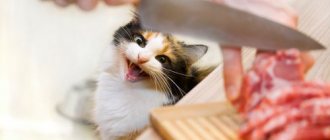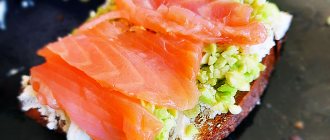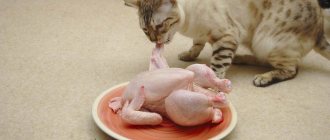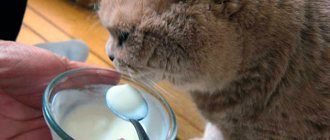When a small meowing pet appears in the house, a very important question arises: what to feed it. After all, the right diet for shaggy food lovers is the key to a long, healthy and happy life.
The ancestors of domestic cats in nature hunted small prey - various birds and mice. These instincts and needs are preserved in pampered pets. Therefore, raw meat and cereals are a more than logical food option for a small predator. Of course, whether it is possible to give a cat raw meat is up to each owner to decide individually, but if you follow simple rules, such a diet will definitely not cause harm.
Natural food or ready-made food
It may seem like why spend time and extra effort to prepare food for cats. After all, there is a huge line of ready-made animal food on sale, from the economy series to the premium class. But how healthy is this food for your pet?
Common inexpensive cat foods contain virtually no ingredients stated on the label. At best, the composition includes meat by-products and soy, which is absolutely not enough for the needs of the animal. But they contain a lot of preservatives and flavorings, which give the food an aroma and taste that is attractive to cats.
Experts do not recommend feeding animals such food for a long time or at least supplementing it with vitamins and mineral supplements.
In feeds of a higher price segment, the content of natural products is much higher. In addition, they already contain vitamins necessary for the animal, and they contain beneficial vitamin E as a preservative. Such food is not only healthy, but also tasty for your pet.
An alternative to these foods can be natural food. Just remember that feeding a cat and eating from the owners’ table are completely different things.
Meat and meat products in a cat's diet
Any lean meat is suitable for feeding cats - beef, veal, turkey, rabbit, chicken. For small kittens, minced meat made from a mixture of turkey and veal is ideal. Deciding whether it is possible to give your cat raw meat or whether it is better to boil it a little first depends on the animal’s preferences - some people do not like boiled food.
Meat by-products (chicken stomachs and hearts), previously well washed and deveined, are also useful for cats. Liver is also good for them, but you shouldn’t get too carried away with it - raw liver weakens you, while boiled liver, on the contrary, strengthens you. Therefore, pre-frozen liver can be given no more than twice a week.
How to cook meat for a cat
To the question of whether a cat can be given raw meat, beef, the answer is yes, but with some conditions. Meat for feeding the animal must first be frozen in the freezer for about two days. This will remove parasites from the meat. Thawed meat should be thoroughly washed and cut into small pieces. Cats are predators; they do not chew their food, but swallow it in pieces; the digestion process itself occurs directly in the stomach. Therefore, the pieces should not be large, two centimeters maximum.
Some experts recommend pouring boiling water over the meat, but this is controversial. After all, in nature, cats hunt and eat raw meat.
If you have doubts about the quality of a meat product or want to diversify your pet’s menu, you can boil it or even stew it. The broth in which the meat was cooked can also be offered to the cat.
Is it possible to feed a cat minced meat?
This is not advisable. The concentration of gastric juice in cats is high: the juice processes the minced meat very quickly - and the product slips through the stomach, as a result of which the beneficial substances do not have time to be absorbed as well as when swallowing pieces. In addition, eating pieces requires effort and time, which allows you to feel full by the end of the meal, while cats may not get enough of pates and ask for more. In addition, jaw work is extremely useful both physiologically and psychologically: it triggers a chain of neuroreactions that promote the development of mental abilities and improve mood - do not deny your cat this pleasure.
Minced meats and pates are served only to cats that have no teeth or are unable to digest pieces (these are sick cats who have appropriate recommendations from a veterinarian). Healthy cats consume meat either in small pieces or large whole pieces. In the second case, they use their teeth to tear off smaller parts from a large piece that are convenient for swallowing.
Features of feeding poultry meat
It would seem that in nature cats eat birds, and if you feed your pet bird meat, no problems should arise. This is absolutely true for turkey and quail meat, but with chicken it can be difficult.
Chicken meat is a fairly strong allergen, so it should be used with caution in cat food. Typically, signs of food allergies in kittens appear at an early age. However, they can also occur in an adult pet. This usually manifests itself in the form of redness of the skin, increasing itching, and hair loss.
Whether it is possible to give a cat raw chicken meat or not is determined by the owners only by experience. If the animal does not have allergic reactions, well-beaten chicken throats can be given to clean the teeth once a week.
Why is the raw product dangerous?
Pets often become infected with salmonella through this product.
If you give your cat raw meat alone, the following problems may occur:
- Infection with helminths. These are roundworms, toxocara, flukes, trichinella, which cause serious organ dysfunction, even death.
- Hyperparathyroidism. Characterized by deformation and fracture of bones, neurological disorders.
- Bacterial infections. Often diagnosed are salmonellosis or colibacillosis, accompanied by diarrhea and general intoxication.
Fish on the cat's menu
The prevailing stereotype that cats eat a lot of fish is absolutely not true. In the natural environment, cats have virtually no opportunity to catch fish.
Domestic cats are often given fish, and this is wrong. All types of river fish are not suitable for cat food: they are very bony and contain many parasites.
You can offer your cat some boiled and boned sea fish. Fatty varieties should also be excluded; excess animal fat will lead to kidney problems in the animal. Also, sea fish contains a small amount of salt, which is contraindicated for cats.
When deciding whether it is possible to give your cat raw meat and fish, the clear choice is made in favor of meat, and the fish must be boiled. You should treat your pet to boiled and deboned fish no more than twice a week. Occasionally, you can pamper your cat with boiled shrimp, after clearing them of their shell.
How to diversify your cat's diet
You cannot feed your cat only meat and meat products. It is very useful to supplement his diet with a variety of cereals (rolled oats, buckwheat, rice, millet). You need to boil porridge in water, although you can use broth from lean meat. Experts recommend adding a little natural vegetable oil to this mixture, this improves the functioning of the animal’s intestines.
Low-fat fermented milk products are also beneficial for domestic cats - yogurt without additives, kefir or sour cream with a fat content of no more than 9%. Contrary to popular belief, milk is absolutely not healthy for cats, and sometimes even harms digestion.
For your pet’s well-being, it is better not to mix meat and dairy products, for example, give porridge with meat and vegetables at lunch, and a bowl of low-fat yogurt or yogurt in the evening.
Cats love domestic eggs, but they should not be given in large quantities either; excess protein can lead to health problems. A raw quail egg can be offered to the cat as a whole, but only the yolk can be given from a boiled chicken egg.
Is it possible to give raw meat to a cat, and what should it be combined with? Vegetables are great. Your pet's diet can be quite varied. If taught from an early age, the cat will eat boiled vegetables (beets, carrots, cauliflower, zucchini) well. They are mixed with meat or boiled fish.
However, there are quite serious restrictions on mixing feed and natural nutrition.
Is it possible to give a cat raw meat and dry food?
Ready-made animal feed and natural food are absolutely incompatible. When bringing a small pet into the home, the owner will need to decide whether to give the animal food or feed it meat products.
Feeding different types of food at the same time can quickly lead to serious problems with the gastrointestinal tract in a cat. This is due to different principles of food digestion. Dry food must be washed down with plenty of water; it swells in the stomach and only then is digested. But with natural nutrition, the food already contains moisture, and the process begins immediately. A cat's digestive system cannot quickly switch from one mode to another.
Therefore, to the common question of whether it is possible to give raw meat to a cat if it is fed dry food, the answer is unequivocal: it is not possible. Sometimes they try to combine wet food with natural food. But taste enhancers and flavorings are often added to ready-made varieties, and after trying them, animals are reluctant to return to regular food.
How much meat does a cat need?
An adult cat can be given 100-150 g of product per day. It is advisable to divide servings into 2-3 doses. The owner should take into account the physiological characteristics of the pet’s body, age-related changes and the degree of activity of the pet’s lifestyle. It is recommended to give the meat product in small pieces. Veterinarians believe that it is better not to feed raw and cooked meat on the same day, since digestion requires different enzymes, and this overloads the digestive system. If your cat does not eat raw food, you can microwave the food for a while. And also, you don’t need to feed your cat only meat, even if the pet loves it very much. Rice is good for cats, but cheese should not be offered - it will cause constipation.
Restrictions when feeding natural food
When accustoming a small cat to natural food, you need to carefully monitor the reaction to the products offered. Cats, like people, have allergies, sometimes quite serious.
You should be careful when giving your cat chicken, eggs, and dairy products. If the animal is reluctant to eat cereal, there is no need to force it. Whether you can give your cat raw meat or boil it is best to decide based on your pet’s preferences.
Under no circumstances should you offer your animal fatty meats (pork, lamb), butter, or fruit. Cats do not tolerate onions well in any form, both raw and boiled. Potatoes are also undesirable; they contain a lot of starch, which they cannot digest at all.
What varieties can be added?
You can use different types of meat.
From time to time it is allowed to pamper your pet with lean beef. This product is rich in protein and taurine, but contains a minimal amount of fat. Before serving to your pet, the meat must be heat treated.
Lean lamb is another type of meat that can be included in a cat’s diet. As with beef, lamb should be cooked in advance. Both types of meat can be used in the animal’s diet every day, but in small quantities.
Rabbit meat is a dietary hypoallergenic product that is easy to digest, low in calories and has a soft fibrous structure. It is recommended to feed animals with poor health, overweight, and kidney failure with this meat. Before adding this product to the diet of a pet suffering from any chronic diseases, you should consult a veterinarian.
Chicken meat is a dietary, easily digestible product containing a large amount of protein. The beneficial properties of chicken allow it to be used in the diet of both young and older animals.
It is important to note that the cat’s menu should include only high-quality chicken that has passed all stages of sanitary and veterinary control. It is strictly forbidden to feed your pets chicken of questionable quality: for example, if there is a suspicion that the product may contain antibiotics or hormones.
Veterinarians also recommend adding by-products (heart, lungs, liver, tripe, kidneys) to the diet of animals
However, the norm should not exceed 200 g per week. Before treating a cat with such a delicacy, the offal must be cleaned of films, residual fat and veins, cut into pieces and scalded with boiling water, then cooled. When planning to treat your pet to beef liver, it is important to consider that in its raw form this product activates intestinal activity, and when cooked, on the contrary, it produces a fixing effect. If the recommended standards are not followed and the product is not processed, the pet may experience both diarrhea and constipation.
Other permitted types of meat that can be given to animals after light heat treatment:
- horsemeat;
- veal;
- goat meat;
- turkey;
- quail.
Before giving meat to your cat, it should be cut into small pieces. In this form, the product is easier and more convenient to heat treat. In addition, it will be easier for an animal to eat chopped meat than to cope with a huge piece. This is especially true for kittens and older animals with worn or broken teeth.
Nutrition for sterilized pets
Natural food is also beneficial for these pets. Can neutered cats be given raw meat? Yes, but you need to calculate the amount correctly.
Neutered animals are less active and more prone to obesity. They can be fed in smaller portions, focusing on lean meats and pureed boiled vegetables. It is also better to choose dairy products for sterilized cats with low fat content.
Regardless of the choice of food for your pet, the main thing is that he is cheerful and energetic, with shiny fur and a good appetite.
What kind of meat should I give to kittens?
Now let's move on to the question of what kind of meat can be given to kittens. Different types of meat are acceptable. It is variety that allows you to make the diet as healthy as possible and not boring for your cat. However, if it is possible to feed only one type of meat and the kitten is not allergic to it, you will have to feed only one.
Chicken meat for kittens
Chicken meat for kittens is a good option. But the answer to the question whether kittens can eat chicken is ambiguous. Chicken itself is a healthy meat, easy to digest and in all respects ideal for starting complementary feeding. However, chicken is not always environmentally friendly: often the meat is soaked in harmful solutions to maintain freshness. Nutritionists also have complaints about the keeping of animals in some poultry farms. Because of all this, many pets have a negative reaction to chicken, or rather, not to the chicken meat itself, but to what it is stuffed with.
The conclusion from here is this: look for a reliable supplier whose chicken does not smell of chemicals, and whose birds are kept in normal conditions. A cat should eat such meat with pleasure, and not turn up its nose. And after the meal there should be no negative reactions: diarrhea, rash, watery eyes, etc. If there is a reaction, you will have to either change the supplier, or if this is impossible, completely abandon chicken in favor of turkey.
Turkey meat for kittens
Turkey is a fairly dietary meat, similar in composition to chicken, but more environmentally friendly. Therefore, it is ideal for feeding your pet, unless, of course, he is allergic to turkey. Turkey is the number two choice, if not number one, when deciding what meat to feed your kittens.
The breast is the least valuable part of the turkey and cannot be the basis of the diet: it does not contain enough fat that cats need so much. But at times when the cat needs to be kept on a gentle diet (for example, after an illness), you can choose the breast. On other days, kittens can easily eat the legs (the fatty parts from under the tail must be cut out).
Duck meat for kittens
Goose meat is quite tough and lean, but duck is fatty, so it is better not to use its skin and subcutaneous fat in feeding kittens. Fortunately, this fat is easily removed - and what remains is excellent meat rich in vitamins and minerals. The best options for duck are the thighs and breast.
Read more about these and other types of meat in the separate publication “What Meat to Give to Cats.”
Article continues after advertisement











